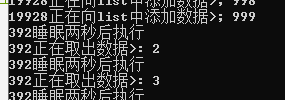C++ condition_variable
君子以阅川 人气:0前言
有这样的需求
一个线程需要等待另一个线程执行完毕之后它才会继续向下执行,这该如何实现? condition_variable类中实现了wait方法
wait()
- 可以接受两个参数,其中第一个参数是锁对象,第二个参数是lambda表达式,其中的lambda表达式的返回值要是bool类型
- 也可接受一个参数,仅仅接受锁对象
#include<iostream>
#include<mutex>
#include<list>
#include<thread>
using namespace std;
class Obj
{
private:
list<int> myList;
condition_variable var;
mutex tex;
public:
bool popFromList(int & comb)
{
if (!myList.empty()) {
unique_lock<mutex> cur(tex);
if (!myList.empty())
{
comb = myList.front();
myList.pop_front();
return true;
}
}
return false;
}
void inToList()
{
for (int i = 0; i < 100; i++)
{
unique_lock<mutex> cur(tex);
myList.push_back(i);
cout << this_thread::get_id() << "正在向list中添加数据>; " << i << endl;
var.notify_one();
}
}
void outFromList()
{
while(true)
{
unique_lock<mutex> cur(tex);
var.wait(cur, [this] {
if (!myList.empty())
return true;
return false;
});
int comb = myList.front();
myList.pop_front();
cout << this_thread::get_id() << "正在取出数据>: " << comb << endl;
}
}
};
int main()
{
Obj obj;
thread thread1(&Obj::outFromList, &obj);
thread thread2(&Obj::inToList, &obj);
thread1.join();
thread2.join();
cout << "这里是主线程" << endl;
}线程1执行到wait函数时,会执行lambda表达式
返回值为false时,这个线程就会将锁打开,将该线程压入到栈中,执行下一个线程 下一个线程执行完毕之后执行notify_one后就会返回到该线程,继续执行lambda表达式
返回值为true时就尝试获得锁
获得锁后继续执行下面的语句
没有获得锁就继续卡在wait等待获取到锁
返回值为false时,继续将锁打开,线程压入栈,执行下一个线程
返回值为true时,线程继续执行
运行结果可能是一个线程执行完毕另一个线程再执行
这不就是顺序执行吗?
其实并不是这样的
notify_one()
唤醒wait()函数,当前所再的线程尝试获得锁
某个线程执行完notify_one函数后,会返回到另一个线程中的wait函数处,并将其"唤醒",让其继续执行,自己的线程和wait线程都尝试获得锁来进行下一步执行
不是顺序执行的解释
- 当wait函数后面有很多语句要执行,但是再此之前wait所在的线程函数中就已经将锁进行释放了,那么notify_one的“唤醒”就不在生效,两个线程都尝试获得锁,但是wait所在的线程有很多语句要执行,耗时高,那么很有可能notify_one所在的线程就再次获得了锁,进行下一步操作。
- 这样就不一定是顺序执行的宏观表现了
#include<iostream>
#include<mutex>
#include<list>
#include<thread>
using namespace std;
class Obj
{
private:
list<int> myList;
condition_variable var;
mutex tex;
public:
bool popFromList(int & comb)
{
if (!myList.empty()) {
unique_lock<mutex> cur(tex);
if (!myList.empty())
{
comb = myList.front();
myList.pop_front();
return true;
}
}
return false;
}
void inToList()
{
for (int i = 0; i < 1000; i++)
{
cout << this_thread::get_id() << "正在向list中添加数据>; " << i << endl;
unique_lock<mutex> cur(tex);
myList.push_back(i);
var.notify_one();
}
}
void outFromList()
{
while(true)
{
unique_lock<mutex> cur(tex);
var.wait(cur, [this] {
if (!myList.empty())
return true;
return false;
});
int comb = myList.front();
myList.pop_front();
cur.unlock();
cout << this_thread::get_id() << "正在取出数据>: " << comb << endl;
chrono::seconds tim(2);
this_thread::sleep_for(tim);
cout <<this_thread::get_id() << "睡眠两秒后执行" << endl;
}
}
};
int main()
{
Obj obj;
thread thread1(&Obj::outFromList, &obj);
thread thread2(&Obj::inToList, &obj);
thread1.join();
thread2.join();
cout << "这里是主线程" << endl;
}如图所示,在notify_one线程执行835次循环后,wait所在的线程才获得了锁,继续执行
在此之前的所有notify_one的唤醒操作都是无效的。
然后在notify_one线程执行完毕之后,wait再次获得了锁,继续向下执行


notify_all()
顾名思义,是“唤醒”所有的wait函数线程,但是并不是都一起运行,因为他们要进行锁的请求,仅仅只能由一把锁存在,只有获得锁并且lambda表达式返回结果为true的线程才能继续执行
加载全部内容